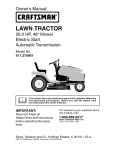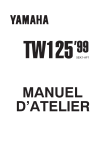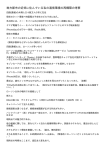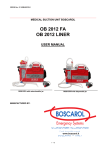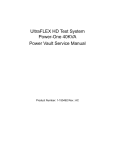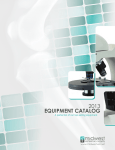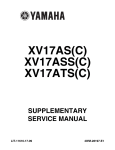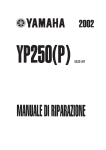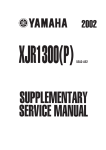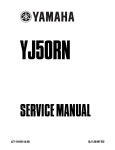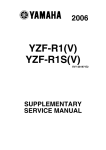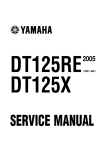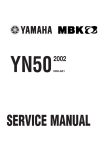Download Yamaha TW125 (5RS1) Service manual
Transcript
FOREWORD This Supplementary Service Manual has been prepared to introduce new service and data for the TW125 2002. For complete service information procedures it is necessary to use this Supplementary Service Manual together with the following manual. TW125 SERVICE MANUAL: 5EK1-AE1 TW125 2002 SUPPLEMENTARY SERVICE MANUAL E2001 by Yamaha Motor Co., Ltd. First Edition, August 2001 Any reproduction or unauthorized use without the written permission of Yamaha Motor Co., Ltd. is expressly prohibited. EB001000 NOTICE This manual was produced by the Yamaha Motor Company primarily for use by Yamaha dealers and their qualified mechanics. It is not possible to include all the knowledge of a mechanic in one manual, so it is assumed that anyone who uses this book to perform maintenance and repairs on Yamaha motorcycle has a basic understanding of the mechanical ideas and the procedures of motorcycle repair. Repairs attempted by anyone without this knowledge are likely to render the motorcycle unsafe and unfit for use. Yamaha Motor Company, Ltd. is continually striving to improve all its models. Modifications and significant changes in specifications or procedures will be forwarded to all authorized Yamaha dealers and will appear in future editions of this manual where applicable. NOTE: Designs and specifications are subject to change without notice. EAS00004 IMPORTANT INFORMATION Particularly important information is distinguished in this manual by the following notations. The Safety Alert Symbol means ATTENTION! BECOME ALERT! YOUR SAFETY IS INVOLVED! WARNING CAUTION: NOTE: Failure to follow WARNING instructions could result in severe injury or death to the motorcycle operator, a bystander or a person inspecting or repairing the motorcycle. A CAUTION indicates special precautions that must be taken to avoid damage to the motorcycle. A NOTE provides key information to make procedures easier or clearer. EAS00007 HOW TO USE THIS MANUAL This manual is intended as a handy, easy-to-read reference book for the mechanic. Comprehensive explanations of all installation, removal, disassembly, assembly, repair and inspection procedures are laid out with the individual steps in sequential order. 1 The manual is divided into chapters. An abbreviation and symbol in the upper right corner of each page indicate the current chapter. Refer to “SYMBOLS” on the following page. 2 Each chapter is divided into sections. The current section title is shown at the top of each page, except in Chapter 3 (“Periodic Inspections and Adjustments”), where the sub-section title(-s) appear. (In Chapter 3, “Periodic Inspections and Adjustments”, the sub-section title appears at the top of each page, instead of the section title.) 3 Sub-section titles appear in smaller print than the section title. 4 To help identify parts and clarify procedure steps, there are exploded diagrams at the start of each removal and disassembly section. 5 Numbers are given in the order of the jobs in the exploded diagram. A circled number indicates a disassembly step. 6 Symbols indicate parts to be lubricated or replaced (see “SYMBOLS”). 7 A job instruction chart accompanies the exploded diagram, providing the order of jobs, names of parts, notes in jobs, etc. 8 Jobs requiring more information (such as special tools and technical data) are described sequentially. 2 1 4 3 8 5 6 7 EAS00009 1 SYMBOLS 2 GEN INFO SPEC 3 4 CHK ADJ ENG The following symbols are not relevant to every vehicle. Symbols 1 to 9 indicate the subject of each chapter. 1 General information 2 Specifications 3 Periodic checks and adjustments 4 Engine 5 Carburetor(-s) 6 Chassis 7 Electrical system 8 Troubleshooting 5 6 CARB CHAS 7 8 ELEC TRBL SHTG 9 10 Symbols 9 to 16 indicate the following. 9 Serviceable with engine mounted 11 12 10 11 12 13 14 15 16 13 14 15 16 17 20 23 18 19 21 22 24 Filling fluid Lubricant Special tool Tightening torque Wear limit, clearance Engine speed Electrical data Symbols 17 to 22 in the exploded diagrams indicate the types of lubricants and lubrication points. 17 18 19 20 21 22 Engine oil Gear oil Molybdenum disulfide oil Wheel bearing grease Lithium soap base grease Molybdenum disulfide grease Symbols 23 to 24 in the exploded diagrams indicate the following: 23 Apply locking agent (LOCTITER) 24 Replace the part CONTENTS SPECIFICATIONS GENERAL SPECIFICATIONS . . . . . . . . . . . . . . . . . . . . . . . . . . . . . . . . . . . . . . . . MAINTENANCE SPECIFICATIONS . . . . . . . . . . . . . . . . . . . . . . . . . . . . . . . . . . ENGINE . . . . . . . . . . . . . . . . . . . . . . . . . . . . . . . . . . . . . . . . . . . . . . . . . . . . . . . . . . . . CHASSIS . . . . . . . . . . . . . . . . . . . . . . . . . . . . . . . . . . . . . . . . . . . . . . . . . . . . . . . . . . . ELECTRICAL . . . . . . . . . . . . . . . . . . . . . . . . . . . . . . . . . . . . . . . . . . . . . . . . . . . . . . CABLE ROUTING . . . . . . . . . . . . . . . . . . . . . . . . . . . . . . . . . . . . . . . . . . . . . . . . . . . . . 1 3 3 4 5 6 PERIODIC CHECKS AND ADJUSTMENTS INTRODUCTION . . . . . . . . . . . . . . . . . . . . . . . . . . . . . . . . . . . . . . . . . . . . . . . . . . . . . . PERIODIC MAINTENANCE/LUBRICATION INTERVALS . . . . . . . . . ENGINE . . . . . . . . . . . . . . . . . . . . . . . . . . . . . . . . . . . . . . . . . . . . . . . . . . . . . . . . . . . . . . . . ADJUSTING THE ENGINE IDLING SPEED . . . . . . . . . . . . . . . . . . . . . ADJUSTING THE THROTTLE CABLE FREE PLAY . . . . . . . . . . . . ELECTRICAL SYSTEM . . . . . . . . . . . . . . . . . . . . . . . . . . . . . . . . . . . . . . . . . . . . . . . CHECKING AND CHARGING THE BATTERY . . . . . . . . . . . . . . . . . . REPLACING THE HEADLIGHT BULB . . . . . . . . . . . . . . . . . . . . . . . . . . . ADJUSTING THE HEADLIGHT BEAM . . . . . . . . . . . . . . . . . . . . . . . . . . . 16 16 18 18 19 21 21 27 28 ENGINE CLUTCH ............................................................... 29 CARBURETOR CARBURETOR . . . . . . . . . . . . . . . . . . . . . . . . . . . . . . . . . . . . . . . . . . . . . . . . . . . . . . . . CHECKING THE CARBURETOR . . . . . . . . . . . . . . . . . . . . . . . . . . . . . . . . ASSEMBLING THE CARBURETOR . . . . . . . . . . . . . . . . . . . . . . . . . . . . . INSTALLING THE CARBURETOR . . . . . . . . . . . . . . . . . . . . . . . . . . . . . . . MEASURING AND ADJUSTING THE FUEL LEVEL . . . . . . . . . . . . 31 34 36 37 37 CHASSIS FRONT WHEEL AHD BRAKE DISC . . . . . . . . . . . . . . . . . . . . . . . . . . . . . . . . . REAR WHEEL AND REAR BRAKE . . . . . . . . . . . . . . . . . . . . . . . . . . . . . . . . . REAR WHEEL . . . . . . . . . . . . . . . . . . . . . . . . . . . . . . . . . . . . . . . . . . . . . . . . . . . . . REAR BRAKE AND REAR WHEEL SPROCKET . . . . . . . . . . . . . . . . FRONT FORK . . . . . . . . . . . . . . . . . . . . . . . . . . . . . . . . . . . . . . . . . . . . . . . . . . . . . . . . . HANDLEBAR . . . . . . . . . . . . . . . . . . . . . . . . . . . . . . . . . . . . . . . . . . . . . . . . . . . . . . . . . . STEERING HEAD . . . . . . . . . . . . . . . . . . . . . . . . . . . . . . . . . . . . . . . . . . . . . . . . . . . . . LOWER BRACKET . . . . . . . . . . . . . . . . . . . . . . . . . . . . . . . . . . . . . . . . . . . . . . . . 39 40 40 42 44 45 47 47 ELECTRICAL SYSTEM IGNITION SYSTEM . . . . . . . . . . . . . . . . . . . . . . . . . . . . . . . . . . . . . . . . . . . . . . . . . . . . 49 CIRCUIT DIAGRAM . . . . . . . . . . . . . . . . . . . . . . . . . . . . . . . . . . . . . . . . . . . . . . . 49 CHECKING THE IGNITION SYSTEM . . . . . . . . . . . . . . . . . . . . . . . . . . . . 50 TW125 2002 WIRING DIAGRAM GENERAL SPECIFICATIONS SPECIFICATIONS GENERAL SPECIFICATIONS Model TW125 Model code: 5RS1, 5RS2 Dimensions: Overall length Overall width Overall height Seat height Wheelbase Minimum ground clearance Minimum turning radius 2,135 mm ,820 mm 1,120 mm ,820 mm 1,350 mm ,255 mm 2,100 mm Carburetor: Type/quantity Manufacturer MV28/1 TEIKEI Transmission: Primary reduction system Primary reduction ratio Secondary reduction system Secondary reduction ratio Transmission type Operation Gear ratio 1st 2nd 3rd 4th 5th Spur gear 74/20 (3.700) Chain drive 51/14 (3.643) Constant mesh 5 speed Left foot operation 36/16 (2.250) 31/21 (1.476) 27/24 (1.125) 25/27 (0.926) 23/29 (0.793) Chassis: Frame type Caster angle Trail Diamond 25_50’ 93 mm Tire: Type Size front rear Manufacture front rear Type front rear Tube type 130/80-18 66P 130/80-18 M/C 66P 180/80-14 M/C 78P BRIDGESTONE BRIDGESTONE TW203 TW204 –1– SPEC GENERAL SPECIFICATIONS Model TW125 Wheel travel: Front wheel travel Rear wheel travel 150 mm 150 mm Electrical: Ignition system Generator system Battery type Battery capacity C.D.I. A.C. magneto GT6B-3 12 V 6 AH Bulb wattage quantity: Headlight Auxiliary light Tail/brake light Turn signal light Meter light High beam indicator light Neutral indicator light Turn signal indicator light 12 V 60 W/55 W 12 V 4 W 1 12 V 5 W/21 W 12 V 21 W 4 12 V 3.4 W 1 12 V 3.4 W 1 12 V 3.4 W 1 12 V 3.4 W 1 –2– 1 1 SPEC MAINTENANCE SPECIFICATIONS SPEC MAINTENANCE SPECIFICATIONS ENGINE Item Standard Limit Clutch: Friction plate thickness Quantity Clutch plate thickness Quantity Clutch spring free length Quantity Push rod bending limit 2.9 X 3.1 mm 5 pcs. 1.6 mm 4 pcs. 34.9 mm 4 pcs. SSS 2.7 mm SSS 0.05 mm SSS 33.9 mm SSS 0.2 mm Carburetor: Type I.D. mark Main jet Main air jet Jet needle Needle jet Pilot air jet 1 Pilot air jet 2 Pilot outlet Pilot jet Bypass 1 Bypass 2 Bypass 3 Bypass 4 Pilot screw Valve seat size Starter jet 1 Starter jet 2 Fuel level Engine idle speed Intake vacuum MV28 5RS1 00 #134 ø1.2 5A50-3/5 B1/60 #90 #120 0.8 #34 0.7 0.7 0.7 0.7 1-1/2 1.6 0.6 0.8 0 X 2.0 mm 1,450 X 1,650 r/min 190 X 230 mmHg SSS SSS SSS SSS SSS SSS SSS SSS SSS SSS SSS SSS SSS SSS SSS SSS SSS SSS SSS SSS (M.J) (M.A.J) (J.N) (N.J) (P.A.J.1) (P.A.J.2) (P.O) (P.J) (B.P.1) (B.P.2) (B.P.3) (B.P.4) (P.S) (V.S) (G.S.1) (G.S.2) (F.L) TIGHTENING TORQUES ENGINE Part to be tightened g Cam sprocket cover Oil filter cover Crankcase (left and right) Generator cover Clutch cover Clutch boss Drive sprocket Pick up coil Stator coil Thread Part name size Screw Screw Screw Screw Screw Nut Bolt Screw Screw –3– M6 M6 M6 M6 M6 M14 M5 M6 M6 Q’ty y 2 2 12 10 10 1 2 2 3 Tightening torque Nm mSkg 10 10 10 10 10 50 4 10 10 1.0 1.0 1.0 1.0 1.0 5.0 0.4 1.0 1.0 Remarks MAINTENANCE SPECIFICATIONS SPEC CHASSIS Item Standard Limit Front suspension: Front fork travel Fork spring free length Fitting length Spring rate (K1) Stroke (K1) Oil capacity Oil level Oil grade Inner tube vend limit 150 mm 330 mm 325 mm 4.9 N/mm (0.49 kg/mm) 0 X 150 mm 0.259 L (259 cm3) 122 mm Fork oil 10 WT or equivalent SSS SSS 323 mm SSS SSS SSS SSS SSS SSS 0.2 mm Rear suspension: Shock absorber stroke Spring free length Fitting length Spring rate (K1) Stroke (K1) 48 mm 190 mm 185 mm 127 N/mm (12.7 kg/mm) 0 X 48 mm SSS 171 mm SSS SSS SSS Drive chain: Type/manufacturer No. of links Chain free play Maximum ten-link section 428HD/DAIDO 125 35 X 60 mm 129.5 mm SSS SSS SSS SSS Leading, trailing 130 mm 4 mm Cam side 52 mm Pin side 48 mm SSS 131 mm 2 mm SSS 5 X 8 mm SSS Rear brake: Type Drum inside diameter Shoe thickness Shoe spring free length Brake lever: Brake lever free play (at lever end) –4– SPEC MAINTENANCE SPECIFICATIONS TIGHTENING TORQUES CHASSIS Part to be tightened g Thread size Headlight and headlight stay Handle crown and steering shaft Steering ring nut Brake hose union bolt (front brake) Swingarm pivot shaft Footrest (left) (right) Rear footrest Brake caliper and front fork Rear wheel sprocket and hub M8 M22 M25 M10 M12 M12 M10 M8 M10 M8 Tightening torque Nm mSkg 16 110 4 30 83 88 48 16 40 43 1.6 11.0 0.4 3.0 8.3 8.8 4.8 1.6 4.0 4.3 Remarks Refer to NOTE NOTE: 1. When tighten the ring nut, should be steady the ball bearings and the steering shaft moving smoothly. 2. First, tighten the ring nut approximately 38 Nm (3.8 mSkg) by using the torque wrench, then loosen the ring nut one turn and retighten the ring nut to specification. ELECTRICAL Item Charging system: Type Model/manufacturer Standard output Stator coil resistance/color Battery: Specific gravity Electric starter system: Type Starter motor: Model/manufacturer Output Armature coil resistance Brush overall length Brush spring pressure Commutator diameter Mica undercut (depth) Standard Limit C.D.I. magneto F5BT/YAMAHA 14 V 170 W/5,000 r/min 0.48 X 0.72 Ω at 20_C/ White – White SSS SSS SSS SSS SSS 1.320 SSS Constant mesh type SSS 5RS/YAMAHA 0.4 kW 0.0126 X 0.0154 Ω at 20_C 10 mm 5.52 X 8.28 N (552 X 828 g) 22 mm 1.5 mm SSS SSS SSS 3.5 mm SSS 21 mm SSS –5– CABLE ROUTING SPEC CABLE ROUTING 1 Brake hose 12 Wire harness 2 Throttle cables 13 Front turn signal light lead (right) 3 Front brake light switch lead 14 Indicator lead 4 Right handlebar switch lead 5 Main switch lead 6 Clutch cable 7 Clutch switch lead 8 Speedometer cable 9 Left handlebar switch lead 10 Front turn signal light lead (left) 11 Meter lead –6– A Clamp the grommet of brake hose with the band. After completion of clamping, cut the surplus part and point it to the backward. B No positioning for the headlight body is specified. C To the headlight CABLE ROUTING 1 Battery positive lead 13 Diode 2 Starter relay 14 Resister lead 3 Starter motor lead 15 Turn signal relay 4 Clamp 5 Ignition coil 6 Throttle cable (pull side) 7 Throttle cable (return side) 8 Throttle cable holder 9 Horn lead 10 Spark plug lead 11 Relay (White) 12 C.D.I. unit –7– SPEC A After clamping the wire harness, point the surplus part to the downward. Clamp the part immediately before the junction to the C.D.I. unit and relay. B Cut it to be 10 mm or less. C Handlebar switch lead (right) and front brake light switch lead should not be twined around. CABLE ROUTING D Clamp the wire harness, handle switch lead, main switch lead, bar switch lead (right), front resonator hose and starter brake light switch lead, clutch cable. switch lead and main switch F Clamp the ignition coil lead and lead. After clamping, point the the ignition coil grand lead horn surplus part to the downward lead. and then cut it. Do not clamp the G Route the wire harness, handleresonator hose and starter bar switch lead (right) and front cable. brake light switch lead through E Clamp the wire harness, handlethe guide. bar switch lead (right), front H Do not bend the lead sharply just brake light switch lead, clutch after the terminal connection. –8– SPEC I Pass the throttle cables through the engine bracket hole. Point the surplus part to the downward and cut the end. J Pass the carburetor heater lead in front of the seat pillar tube so that it is not caught between the side cover flange and seat pillar tube frame. K Point the rear brake switch lead wire to the rear side of frame. CABLE ROUTING L Clamp the rear brake switch lead O Clamp the wire harness and connector and turn signal relay diode. Point the surplus part to lead with the band and point the the downward. surplus part to the inner side, then cut it. Secure the connector at the front part of frame. M Push the wire harness in between frame and box. N Place the C.D.I. unit on the mounting port for the left side relay. –9– SPEC CABLE ROUTING 1 Resonator hose 13 Clutch cable guide 2 Fuel hose 14 Brake hose 3 Rectifier/ regulator lead 15 Speedometer cable 4 Thermo switch lead 16 Handlebar switch lead (left) 5 Sidestand switch lead 17 Clamp 6 Air filter case 18 Flange bolt 7 Breather hose 19 Brake hose holder 8 Battery negative lead 9 C.D.I. magneto leads 10 Over flow hose 11 Air vent hose 12 Clutch cable –10– SPEC A Clamp between the positioning belts of resonator hose. Do not pinch the resonator hose. B Starter cable, clutch switch lead and main switch lead should not be twined around. C Clamp at the point ahead of the part where resonator hose protector is torn. Do not pinch the resonator hose. D Place the coupler below the resonator hose. CABLE ROUTING E Clamp the rectifier / regulator lead and resonator hose. Point the surplus part toward the inner side. Clamp within a range where the resonator hose protector is torn. Do not pinch the resonator hose. F Place the air vent hose in the inner side of the main pipe. G Clamp the C.D.I. magneto lead at the frame pipe bend and point the surplus part to the inner SPEC side, then cut it. tween engine and swingarm. H Clamp the sidestand switch M Route the neutral switch lead belead. tween engine and swingarm. I Clamp the air vent hose, over N Route the air vent hose and over flow hose, starter motor lead and flow hose through the engine neutral switch lead. guide. J Hold down the side stand switch O To the fuel cock. lead using the special washer. P Route the horn lead through inK Route the air vent hose and over side the clutch cable. flow hose between engine and Q Insert the starter cable to the swingarm. clamp. L Route the starter motor lead be- –11– CABLE ROUTING R Clamp the brake hose and V Place the speedometer cable in speedometer cable. Align the the inner side. clamping position with the center W After tightening screws, insert of white paint mark on the brake the hose in the screw section. hose. X Distortion should be within this S Clamp the brake hose and range toward the traveling direcspeedometer cable with a holdtion of vehicle. er. Y Place the brake hose in the outer T Point the speedometer cable side. cap to the backward. U Make sure to push in the boot fully. –12– SPEC CABLE ROUTING 1 Handlebar switch lead (right) 13 Battery negative lead 2 Front brake light switch lead 14 Grommet 3 Brake hose 15 Rectifier/ regulator 4 Throttle cable (return side) 16 Clamp (rectifier / regulator lead) 5 Throttle cable (pull side) 17 Handlebar switch lead (left) 6 Starter motor lead 18 Clutch switch lead 7 Battery positive lead 19 Clutch cable 8 Wire harness 20 Master cylinder 9 Clamp (wire harness) 21 Starter cable 10 Thermo switch lead 22 Rear turn signal light lead 11 Sidestand switch lead 23 Turn signal light stay SPEC 24 C.D.I. magneto leads, neutral switch lead 12 Negative lead –13– CABLE ROUTING A Clamp the handlebar switch lead D Clamp the wire harness and rear and front brake light switch lead turn signal light lead (right). Point with a band. the surplus part to the inner side. B Clamp the throttle cables. E Cover the naked part of rear turn C Clamp the C.D.I. magneto lead signal light lead (right) with the (2 leads), starter motor lead, hose. neutral switch lead, battery neg- F Cover the naked part of rear turn ative lead and pass them signal light lead (left) with the through the frame gusset hole, hose. then point the surplus part to the G Clamp the wire harness and rear inner side. turn signal lead (right). –14– SPEC H Pass the rear turn signal light lead (right) between the rear frame and license bracket, avoiding to be caught. I Pass the rear turn signal light lead (left) between the rear frame and license bracket, avoiding to be caught. J Clamp the rear turn signal light lead (left). After clamping, point the surplus part to the inner side. CABLE ROUTING K Clamp the thermo switch lead O Clamp the handlebar switch lead coupler. After clamping, point (left) and clutch switch lead. the surplus part to the inner side. P After clamping, cut where it is not L Pass the C.D.I. magneto lead (2 visible either from the top or the leads) through the grommet rear. side. M Place the cover to the corner of rectifier / regulator. N No special order is set for the C.D.I. magneto lead (2 leads), neutral switch lead, starter motor lead and battery negative lead. –15– SPEC INTRODUCTION PERIODIC MAINTENANCE/LUBRICATION INTERVALS CHK ADJ EAS00036 PERIODIC CHECKS AND ADJUSTMENTS INTRODUCTION This chapter includes all information necessary to perform recommended checks and adjustments. If followed, these preventive maintenance procedures will ensure more reliable vehicle operation, a longer service life and reduce the need for costly overhaul work. This information applies to vehicles already in service as well as to new vehicles that are being prepared for sale. All service technicians should be familiar with this entire chapter. EAS00037 PERIODIC MAINTENANCE/LUBRICATION INTERVALS NOTE: S The annual checks must be performed every year, except if a kilometer-based maintenance is performed instead. S From 30,000 km, repeat the maintenance intervals starting from 6,000 km. S Items marked with an asterisk should be performed by a Yamaha dealer as they require special tools, data and technical skills. NO. ITEM ODOMETER READING ( 1,000 km) CHECK OR MAINTENANCE JOB 1 1 * 2 6 12 18 24 Fuel line S Check fuel hoses for cracks or damage. √ √ √ √ Spark p plug p g S Check condition. S Clean and regap. √ S Replace. 3 * 4 6 7 8 Valves Air filter element 5 Clutch * * * ANNUAL CHECK Front brake Rear brake Brake hose √ √ S Check valve clearance. S Adjust. √ S Clean. √ S Replace. √ √ √ √ √ S Check operation, fluid level and vehicle for fluid leakage. √ √ S Replace brake pads. √ √ √ S Check operation. S Adjust. √ √ √ √ √ √ √ S Check operation and adjust brake pedal free play. √ √ S Replace brake shoes. √ √ √ √ S Replace. √ √ √ S Check runout, spoke tightness and for damage. S Tighten spokes if necessary. √ √ √ √ 10 * Tires S S S S √ √ √ √ 11 * Wheel bearings S Check bearing for looseness or damage. √ √ √ √ 12 * Swingarm S Check operation and for excessive play. √ √ √ √ 15 * * 16 Steering bearings √ Every 4 years Wheels 14 √ Whenever worn to the limit S Check for cracks or damage. * Drive chain √ Whenever worn to the limit 9 13 √ Check tread depth and for damage. Replace if necessary. Check air pressure. Correct if necessary. S Lubricate with lithium-soap-based grease. Every 24,000 km S Check chain slack. S Make sure that the rear wheel is properly aligned. S Clean and lubricate. S Check bearing play and steering for roughness. √ Every 500 km and after washing the motorcycle or riding in the rain √ √ S Lubricate with lithium-soap-based grease. √ √ √ Every 24,000 km Chassis fasteners S Make sure that all nuts, bolts and screws are properly tightened. √ √ √ √ √ Sidestand S Check operation. S Lubricate. √ √ √ √ √ √ 17 * Sidestand switch S Check operation. √ √ √ √ 18 * Front fork S Check operation and for oil leakage. √ √ √ √ √ 19 * Shock absorber assembly S Check operation and shock absorber for oil leakage. √ √ √ √ –16– CHK ADJ PERIODIC MAINTENANCE/LUBRICATION INTERVALS NO. ITEM ODOMETER READING ( 1,000 km) CHECK OR MAINTENANCE JOB 1 S Check operation. ANNUAL CHECK 6 12 18 24 √ √ √ √ 20 * Rear suspension relay arm and connecting arm pivoting points 21 * Carburetor S Check starter (choke) operation. S Adjust engine idling speed. √ √ √ √ √ √ 22 Engine oil S Change. S Check oil level and vehicle for oil leakage. √ √ √ √ √ √ 23 Engine oil filter element S Clean. √ * Engine oil strainer S Clean. √ * Front and rear brake switches S Check operation. √ Moving parts and cables S Lubricate. Lights, signals and switches S Check operation. S Adjust headlight beam. 24 25 26 27 * S Lubricate with lithium-soap-based grease. √ √ √ √ √ √ √ √ √ √ √ √ √ √ √ √ √ √ √ √ NOTE: D The air filter needs more frequent service if you are riding in unusually wet or dusty areas. D Hydraulic brake service S Regularly check and, if necessary, correct the brake fluid level. S Every two years replace the internal components of the brake master cylinder and caliper, and change the brake fluid. S Replace the brake hoses every four years and if cracked or damaged. –17– ADJUSTING THE ENGINE IDLING SPEED CHK ADJ ENGINE EAS00054 ADJUSTING THE ENGINE IDLING SPEED NOTE: Prior to adjusting the engine idling speed, the air filter should be clean, and the engine should have adequate compression. 1. Start the engine and let it warm up for several minutes. 2. Install: S engine tachometer (to the spark plug lead) Engine tachometer 90890-03113 3. Measure: S engine idling speed Out of specification ! Adjust. Engine idling speed 1,450 X 1,650 r/min 4. Adjust: S engine idling speed a. Turn the pilot screw 1 in or out until it is lightly seated. b. Turn the pilot screw out the specified number of turns. Pilot screw 1-1/2 turns out c. Turn the throttle stop screw 2 in direction a or b until the specified engine idling speed is obtained. Direction a ! Engine idling speed is increased. Direction b ! Engine idling speed is decreased. 5. Adjust: S throttle cable free play Refer to “ADJUSTING THE THROTTLE CABLE FREE PLAY”. Throttle cable free play (at the flange of the throttle grip) 3 X 5 mm –18– ADJUSTING THE THROTTLE CABLE FREE PLAY CHK ADJ EAS00058 ADJUSTING THE THROTTLE CABLE FREE PLAY NOTE: Prior to adjusting the throttle cable free play, the engine idling speed should be adjusted. 1. Check: S throttle cable free play a Out of specification ! Adjust. Throttle cable free play (at the flange of the throttle grip) 3 X 5 mm 2. Adjust: S throttle cable free play NOTE: When the motorcycle is accelerating, the accelerator cable 1 is pulled. Carburetor side a. Loosen the locknut 2 on the decelerator cable. b. Turn the adjusting nut 3 in direction a or b to take up any slack on the decelerator cable. c. Loosen the locknut 4 on the accelerator cable 1 . d. Turn the adjusting nut 5 in direction a or b until the specified throttle cable free play is obtained. Direction a Throttle cable free play is increased. Direction b Throttle cable free play is decreased. e. Tighten the locknuts. NOTE: If the specified throttle cable free play cannot be obtained on the carburetor side of the cable, use the adjusting nut on the handlebar side. Handlebar side a. Slide back the rubber cover 1 . b. Loosen the locknut 2 . c. Turn the adjusting nut 3 in direction a or b until the specified throttle cable free play is obtained. –19– ADJUSTING THE THROTTLE CABLE FREE PLAY CHK ADJ Direction a Throttle cable free play is increased. Direction b Throttle cable free play is decreased. d. Tighten the locknut. WARNING After adjusting the throttle cable free play, turn the handlebars to the right and to the left to ensure that this does not cause the engine idling speed to change. –20– CHECKING AND CHARGING THE BATTERY CHK ADJ EAS00178 ELECTRICAL SYSTEM CHECKING AND CHARGING THE BATTERY WARNING Batteries generate explosive hydrogen gas and contain electrolyte which is made of poisonous and highly caustic sulfuric acid. Therefore, always follow these preventive measures: S Wear protective eye gear when handling or working near batteries. S Charge batteries in a well-ventilated area. S Keep batteries away from fire, sparks or open flames (e.g., welding equipment, lighted cigarettes). S DO NOT SMOKE when charging or handling batteries. S KEEP BATTERIES AND ELECTROLYTE OUT OF REACH OF CHILDREN. S Avoid bodily contact with electrolyte as it can cause severe burns or permanent eye injury. First aid in case of bodily contact: External S SKIN – Wash with water. S EYES – Flush with water for 15 minutes and get immediate medical attention. Internal S Drink large quantities of water or milk followed with milk of magnesia, beaten egg or vegetable oil. Get immediate medical attention. CAUTION: S This is a sealed battery. Never remove the sealing caps because the balance between cells will not be maintained and battery performance will deteriorate. S Charging time, charging amperage and charging voltage for a MF battery are different from those of conventional batteries. The MF battery should be charged as explained in the charging method illustrations. If the battery is overcharged, the electrolyte level will drop considerably. Therefore, take special care when charging the battery. –21– CHECKING AND CHARGING THE BATTERY CHK ADJ NOTE: Since MF batteries are sealed, it is not possible to check the charge state of the battery by measuring the specific gravity of the electrolyte. Therefore, the charge of the battery has to be checked by measuring the voltage at the battery terminals. 1. Remove: S seat 2. Disconnect: S battery leads (from the battery terminals) CAUTION: First, disconnect the negative lead 1 , then the positive lead 2 . 3. Remove: S battery 4. Check: S battery charge a. Connect a pocket tester to the battery terminals. Open-circuit voltage (V) Tester positive lead ! battery positive Tester positive lead ! terminal Tester negative lead ! battery negative Tester negative lead ! terminal 13.0 NOTE: S The charge state of a MF battery can be checked by measuring its open-circuit voltage (i.e., the voltage when the positive terminal is disconnected). S No charging is necessary when the open-circuit voltage equals or exceeds 12.8 V. Relationship between the open-circuit voltage and the charging time at 20_C 12.5 12.0 11.5 5 6.5 10 Charging time (hours) These values vary with the temperature, the condition of the battery plates, and the electrolyte level. b. Check the charge of the battery, as shown in the charts and the following example. Example c. Open-circuit voltage = 12.0 V d. Charging time = 6.5 hours e. Charge of the battery = 20 X 30% –22– CHECKING AND CHARGING THE BATTERY CHK ADJ 5. Charge: S battery (refer to the appropriate charging method illustration) Charging Open-circuit voltage (V) Ambient temperature 20_C WARNING Do not quick charge a battery. Time (minutes) Check the open-circuit voltage. CAUTION: S Make sure that the battery vent is free of obstructions. S Never remove the MF battery sealing caps. S Do not use a high-rate battery charger. They force a high-amperage current into the battery quickly and can cause battery overheating and battery plate damage. S If it is impossible to regulate the charging current on the battery charger, be careful not to overcharge the battery. S When charging a battery, be sure to remove it from the motorcycle. (If charging has to be done with the battery mounted on the motorcycle, disconnect the negative lead from the battery terminal.) S To reduce the chance of sparks, do not plug in the battery charger until the battery charger leads are connected to the battery. S Before removing the battery charger lead clips from the battery terminals, be sure to turn off the battery charger. S Make sure that the battery charger lead clips are in full contact with the battery terminal and that they are not shorted. A corroded battery charger lead clip may generate heat in the contact area and a weak clip spring may cause sparks. S If the battery becomes hot to the touch at any time during the charging process, disconnect the battery charger and let the battery cool before reconnecting it. Hot batteries can explode! S As shown in the following illustration, the open-circuit voltage of a MF battery stabilizes about 30 minutes after charging has been completed. Therefore, wait 30 minutes after charging is completed before measuring the open-circuit voltage. Open-circuit voltage (V) Ambient temperature 20_C Charging condition of the battery (%) –23– CHK ADJ CHECKING AND CHARGING THE BATTERY Charging method using a variable voltage charger Measure the open-circuit voltage prior to charging. Connect a charged and AMP meter to the battery and start charging. YES Make sure that the current is higher than the standard charging current written on the battery. NOTE: Voltage should be measured 30 minutes after the machine is stopped. NOTE: Set the charging voltage at 16 X 17 V. (If the setting is lower, charging will be insufficient. If too high, the battery will be over-charged.) NO By turning the charging voltage adjust dial, set the charging voltage at 20 X 24 V. Adjust the voltage so that the current is at the standard charging level. YES Monitor the amperage for 3 X 5 minutes to check if the standard charging current is reached. NO Set the time according to the charging time suitable for the open-circuit voltage. Refer to “Battery condition checking steps”. If the current does not exceed the standard charging current after 5 minutes, replace the battery. If charging requires more than 5 hours, it is advisable to check the charging current after a lapse of 5 hours. If there is any change in the amperage, readjust the voltage to obtain the standard charging current. Measure the battery open-circuit voltage after leaving the battery unused for more than 30 minutes. 12.8 V or more --- Charging is complete. 12.7 V or less --- Recharging is required. Under 12.0 V --- Replace the battery. –24– CHECKING AND CHARGING THE BATTERY CHK ADJ Charging method using a constant voltage charger Measure the open-circuit voltage prior to charging. NOTE: Voltage should be measured 30 minutes after the machine is stopped. Connect a charger and AMP meter to the battery and start charging. YES Make sure that the current is higher than the standard charging current written on the battery. Charge the battery until the battery’s charging voltage is 15 V. Charge the battery until the battery’s charging voltage is 15 V. NO This type of battery charger cannot charge the MF battery. A variable voltage charger is recommended. NOTE: Set the charging time at 20 hours (maximum). Measure the battery open-circuit voltage after leaving the battery unused for more than 30 minutes. 12.8 V or more --- Charging is complete. 12.7 V or less --- Recharging is required. Under 12.0 V --- Replace the battery. –25– CHECKING AND CHARGING THE BATTERY CHK ADJ 6. Check: S battery vent Obstruction ! Clean. Damage ! Replace. 7. Install: S battery 8. Connect: S battery leads (to the battery terminals) CAUTION: First, connect the positive lead 1 , then the negative lead 2 . 9. Check: S battery terminals Dirt ! Clean with a wire brush. Loose connection ! Connect properly. 10. Lubricate: S battery terminals Recommended lubricant Dielectric grease 11. Install: S seat –26– REPLACING THE HEADLIGHT BULB CHK ADJ EAS00182 REPLACING THE HEADLIGHT BULB 1. Remove: S bolts 1 S headlight unit 2. Disconnect: S headlight coupler 1 S headlight bulb cover 2 3. Remove: S headlight bulb holder 1 S headlight bulb 2 WARNING Since the headlight bulb gets extremely hot, keep flammable products and your hands away from the bulb until it has cooled down. 4. Install: S headlight bulb New Secure the new headlight bulb with the headlight bulb holder. CAUTION: Avoid touching the glass part of the headlight bulb to keep it free from oil, otherwise the transparency of the glass, the life of the bulb and the luminous flux will be adversely affected. If the headlight bulb gets soiled, thoroughly clean it with a cloth moistened with alcohol or lacquer thinner. 5. Install: S headlight bulb holder 6. Connect: S headlight bulb holder S headlight coupler 7. Install: S headlight unit –27– ADJUSTING THE HEADLIGHT BEAM CHK ADJ EAS00184 ADJUSTING THE HEADLIGHT BEAM 1. Adjust: S headlight beam (vertically) a. Turn the adjusting screw 1 in direction a or b. Direction a ! Headlight beam is raised. Direction b ! Headlight beam is lowered. 2. Adjust: S headlight beam (horizontally) a. Turn the adjusting knob 2 in direction a or b. Direction a ! Headlight beammoves to the right. Direction b ! Headlight beammoves to the left. –28– CLUTCH ENG EAS00274 ENGINE CLUTCH 8 Nm (0.8 mSkg) 70 Nm (7.0 mSkg) 12 Nm (1.2 mSkg) 6 Nm (0.6 mSkg) Order 1 2 3 4 5 6 7 8 9 10 11 Job/Part Removing the clutch Clutch springs Pressure plate Friction plates Clutch plates Nut/Lock washer Clutch boss Thrust washer Clutch housing Ball Long clutch push rod Push lever screw/Gasket Q’ty Remarks Remove the parts in the order listed. 4 1 5 4 1/1 1 1 1 1 1 1/1 –29– Refer to “REMOVING/INSTALLING THE CLUTCH” section in chapter 4. (Manual No.: 5EK1-AE1) CLUTCH 8 Nm (0.8 mSkg) ENG 70 Nm (7.0 mSkg) 12 Nm (1.2 mSkg) 6 Nm (0.6 mSkg) Order Job/Part Q’ty 1 12 Push lever axle 13 14 15 16 Torsion spring Circlip Oil seal Nut/Washer 1 1 1 1/1 17 18 Short clutch push rod/O-ring Push plate 1/1 1 Remarks Refer to “INSTALLING THE CLUTCH” section in chapter 4. (Manual No.: 5EK1-AE1) Refer to “INSTALLING THE CLUTCH” section in chapter 4. (Manual No.: 5EK1-AE1) For installation, reverse the removal procedure. –30– CARBURETOR ENG EAS00480 CARBURETOR CARBURETOR Order 1 2 3 4 Job/Part Q’ty Remarks Removing the carburetor Side cover Seat Fuel tank Remove the parts in order listed. Refer to “SEAT, FUEL TANK AND SIDE COVER” section in chapter 3. (Manual No.: 5EK1-AE1) Heater unit lead Starter cable NOTE: S Disconnect the connector from carburetor. S Disconnect the starter cable. Carburetor joint clamp screw Air filter joint clamp screw Carburetor assembly Throttle cables 1 1 1 2 Loosen. For installation, reverse the removal procedure. –31– CARBURETOR ENG EAS00483 Order 1 2 3 4 5 6 7 8 9 10 11 Job/Part Disassembly the carburetor Vacuum chamber cover Piston valve spring Jet needle holder Jet needle spring Jet needle Piston valve Carburetor heater Adjusting screw Drain screw Float chamber Gasket Q’ty Remarks Disassemble the parts in the order listed. 1 1 1 1 1 1 1 1 1 1 1 –32– Refer to “ASSEMBLING THE CARBURETOR”. CARBURETOR Order 12 13 14 15 16 17 18 19 20 21 22 23 Job/Part Float pin Float Needle valve Needle valve seat Main jet Main jet holder Needle jet Pilot jet Pilot screw Rubber diaphragm spring Rubber diaphragm Starter plunger Q’ty 1 1 1 1 1 1 1 1 1 1 1 1 ENG Remarks Refer to “ASSEMBLING THE CARBURETOR”. For assembly, reverse the disassembly procedure. –33– CARBURETOR CARB EAS00485 CHECKING THE CARBURETOR 1. Check: S carburetor body S float chamber S jet housing Cracks/damage ! Replace. 2. Check: S fuel passages Obstruction ! Clean. a. Wash the carburetor in a petroleum-based solvent. Do not use any caustic carburetor cleaning solution. b. Blow out all of the passages and jets with compressed air. 3. Check: S float chamber body Dirt ! Clean. 4. Check: S float chamber rubber gasket Cracks/damage/wear ! Replace. 5. Check: S float Damage ! Replace. 6. Check: S needle valve 1 S needle valve seat 2 Damage/obstruction/wear ! Replace the needle valve, needle valve seat and O-ring as a set. 7. Check: S O-ring 3 Damage/wear ! Replace the needle valve, needle valve seat and O-ring as a set. –34– CARBURETOR CARB 8. Check: S piston valve 1 Damage/scratches/wear ! Replace. S rubber diaphragm 2 Cracks/tears ! Replace. 9. Check: S vacuum chamber cover 1 S piston valve spring 2 S jet needle holder 3 S jet needle spring 4 Cracks/damage ! Replace. 10. Check: S jet needle kit 1 S needle jet 2 S main jet 3 S main jet holder 4 S pilot jet 5 S pilot screw 6 Bends/damage/wear ! Replace. Obstruction ! Clean. Blow out the jets with compressed air. 11. Check: Spiston valve movement Insert the piston valve into the carburetor body and move it up and down. Tightness ! Replace the piston valve. 12 Check: S starter plunger 1 S starter plunger spring 2 Bends/cracks/damage ! Replace. –35– CARBURETOR CARB 13. Check: S fuel hoses Cracks/damage/wear ! Replace. Obstruction ! Clean. Blow out the hoses with compressed air. EAS00487 ASSEMBLING THE CARBURETOR CAUTION: S Befor assembling the carburetor, wash all of the parts in a petroleum-based solvent. S Always use a new gasket. 1. Install: S needle jet S main jet 1 S main jet holder 2 S pilot jet 3 2. Install: S needle valve seat 1 3. Install: S float 1 S needle valve S float pin 2 NOTE: Install the float pin from the side opposite the arrow. –36– CARBURETOR CARB 4. Install: S float chamber 1 S pilot screw 2 5. Install: S starter plunger kit 1 EAS00492 INSTALLING THE CARBURETOR 1. Adjust: S engine idling speed Engine idling speed 1,450 X 1,650 r/min Refer to “ADJUSTING THE ENGINE IDLING SPEED” 2. Adjust: S throttle cable free play Throttle cable free play (at the flange of the throttle grip) 3 X 5 mm Refer to “ADJUSTING THE THROTTLE CABLE FREE PLAY”. EAS00498 MEASURING AND ADJUSTING THE FUEL LEVEL 1. Measure: S fuel level a Out of specification ! Adjust. Fuel level (below the float chamber mating surface) 0 X 2.0 mm –37– CARBURETOR CARB a. Stand the motorcycle on a level surface. b. Place the motorcycle on a suitable stand to ensure that the motorcycle is standing straight up. c. Install the fuel level gauge 1 to the fuel drain pipe 2 . Fuel level gauge 90890-01312 d. Loosen the fuel drain screw 3 . e. Hold the fuel level gauge vertically next to the float chamber. f. Measure the fuel level a . 2. Adjust: S fuel level a. Remove the carburetor. b. Check the needle valve seat and needle valve. c. If either is worn, replace them as a set. d. If both are fine, adjust the float level by slightly bending the float tang 1 . e. Install the carburetor. f. Measure the fuel level again. g. Repeat steps (a) to (f) until the fuel level is within specification. –38– FRONT WHEEL AND BRAKE DISC CHAS EAS00512 CHASSIS FRONT WHEEL AND BRAKE DISC 90 Nm (9.0 mSkg) 13 Nm (1.3 mSkg) Order Job/Part Q’ty Remove the parts in the order listed. NOTE: Place the motorcycle on a suitable stand so that the front wheel is elevated. Removing the front wheel and brake disc 1 2 3 4 5 6 7 Caps Speedometer cable Wheel axle Front wheel assembly Collar Meter gear unit assembly Brake disc Remarks 2 1 1 1 1 1 1 Refer to “REMOVING/INSTALLING THE FRONT WHEEL” section in chapter 6. (Manual No.: 5EK1-AE1) For installation, reverse the removal procedure. –39– REAR WHEEL AND REAR BRAKE CHAS REAR WHEEL AND REAR BRAKE REAR WHEEL 90 Nm (9.0 mSkg) Order Job/Part Q’ty Remove the parts in the order listed. NOTE: Place the motorcycle on a suitable stand so that the rear wheel is elevated. Removing the rear wheel 1 2 3 4 5 6 7 8 Adjuster Brake rod Pin Compression spring Chain case Axle nut/washer Chain pullers Wheel axle Remarks 1 1 1 1 1 1/1 2 1 –40– Refer to “REMOVING/INSTALLING THE REAR WHEEL” section in chapter 6. (Manual No.: 5EK1-AE1) REAR WHEEL AND REAR BRAKE CHAS 90 Nm (9.0 mSkg) Order Job/Part Q’ty Remarks Refer to “REMOVING /INSTALLING THE REAR WHEEL” section in chapter 6. (Manual No.: 5EK1-AE1) 9 Rear wheel assembly 1 10 Collar 2 For installation, reverse the removal procedure. –41– REAR WHEEL AND REAR BRAKE CHAS REAR BRAKE AND REAR WHEEL SPROCKET 43 Nm (4.3 mSkg) Order 1 2 3 Job/Part Removing the rear brake and rear wheel sprocket Shoe plate Nuts Driven sprocket Q’ty Remarks Remove the parts in the order listed. 1 6 1 –42– Refer to “ASSEMBLYNG THE REAR WHEEL” section in chapter 6. (Manual No.: 5EK1-AE1) For installation, reverse the removal procedure. REAR WHEEL AND REAR BRAKE Order 1 2 3 4 Job/Part Disassembling the rear wheel Bearing Spacer Oil seal Bearing Q’ty CHAS Remarks Disassemble the parts in the order listed. 1 1 1 1 For assembly, reverse the disassembly procedure. –43– FRONT FORK CHAS FRONT FORK 23 Nm (2.3 mSkg) 23 Nm (2.3 mSkg) 23 Nm (2.3 mSkg) 30 Nm (3.0 mSkg) Order Job/Part Q’ty Remove the parts in the order listed. Refer to “FRONT WHEEL AND BRAKE DISC”. Removing the front fork Front wheel 1 2 3 4 5 6 7 8 Brake hose holder Caliper Front fender Cap bolt/O-ring Bolt (upper bracket) Bolts (under bracket) Front fork assembly (left) Front fork assembly (right) Remarks 1 1 1 1/1 1 2 1 1 Refer to “REMOVING/INSTALLING THE FRONT FORK” section in cahpter 6. (Manual No.: 5EK1-AE1) NOTE: Loosen the bolt. For installation, reverse the removal procedure. –44– HANDLEBAR CHAS HANDLEBAR 20 Nm (2.0 mSkg) Order 1 2 3 4 5 6 7 Job/Part Removing the handlebar Master cylinder bracket Master cylinder Housing (throttle grip) Throttle grip assembly Handlebar switch (right) Clutch switch Clutch cable Q’ty Remarks Remove the parts in the order listed. 1 1 1 1 1 1 1 –45– Refer to “INSTALLING THE HANDLEBAR” section in chapter 6. (Manual No.: 5EK1-AE1) HANDLEBAR CHAS 20 Nm (2.0 mSkg) Order Job/Part Q’ty 8 9 Handlebar switch (left) Grip (left) 1 1 10 11 12 Clutch lever Starter cable holder Upper holders 1 1 2 13 Handlebar 1 Remarks Refer to “REMOVING THE HANDLEBAR” section in chapter 6. (Manual No.: 5EK1-AE1) Refer to “INSTALLING THE HANDLEBAR” section in chapter 6. (Manual No.: 5EK1-AE1) For installation, reverse the removal procedure. –46– STEERING HEAD CHAS STEERING HEAD LOWER BRACKET 90 Nm (9.0 mSkg) 1st 38 Nm (3.8 mSkg) 2nd 18 Nm (1.8 mSkg) Order 1 2 3 4 5 6 7 8 9 10 11 12 13 Job/Part Removing the lower bracket Front fork Handlebar Headlight unit Headlight body Turn signal light assembly (left) Turn signal light assembly (right) Meter cable/Meter lead Meter assembly Headlight stay Steering stem nut Handlebar crown Lock washer Upper ring nut Rubber washer Lower ring nut Q’ty Remarks Remove the parts in the order listed. Refer to “FRONT FORK”. Refer to “HANDLEBAR” 1 1 1 1 1/1 NOTE: Disconnect the connector. 1 2 1 1 1 1 1 Refer to “INSTALLING THE STEERING 1 HEAD” section chapter 6. (Manual No.: 5EK1-AE1) –47– STEERING HEAD CHAS 90 Nm (9.0 mSkg) 1st 38 Nm (3.8 mSkg) 2nd 18 Nm (1.8 mSkg) Order 14 15 16 17 18 19 20 Job/Part Ball race ccver Lower bracket Ball race (upper) Ball Ball Ball race (center) Ball race (lower) Q’ty 1 1 1 22 19 1 1 Remarks Refer to “INSTALLING THE STEERING” section in chapter 6. (Manual No.: 5EK1-AE1) For installation, reverse the removal procedure. –48– IGNITION SYSTEM ELEC EAS00734 ELECTRLCAL SYSTEM IGNITION SYSTEM CIRCUIT DIAGRAM 1 C.D.I. magneto 2 Neutral switch 4 Battery 6 Fuse 10 Engine stop switch 11 Main switch 13 Diode 14 C.D.I. unit 15 Ignition coil 16 Spark plug 22 Neutral relay 24 Reed switch –49– IGNITION SYSTEM EAS00798 CHECKING THE IGNITION SYSTEM. 1. The speedometer fail to come on. 1. Reed switch S Remove the meter assembly. S Connect the pocket tester (Ω reed switch coupler as shown. 1) to the Tester positive probe ! white/black 1 Tester negative probe ! red/blue 2 S Make the speedometer indicate S Check the continuity or open circuit status. S If it counts 4 cycles of continuity and open actions per speedometer rotation, the result is acceptable. S Is the reed switch OK? YES Properly connect or repair the ignition system. NO Replace the reed switch. –50– ELEC TW125 2002 WIRING DIAGRAM 1 2 3 4 5 6 7 8 9 10 11 12 13 14 15 16 17 18 19 20 21 22 23 24 25 26 27 28 29 30 31 32 33 34 35 36 37 38 39 40 41 42 COLOR CODE B ......... Br . . . . . . . . . Ch . . . . . . . . Dg . . . . . . . . G ......... L .......... O ......... Black Brown Chocolate Dark green Green Blue Orange Sb . . . . . . . . P ......... R ......... Y ......... W ......... B/ R . . . . . . B/ W . . . . . . Sky blue Pink Red Yellow White Black/ Red Black/ White Br/ L . . . . . . Br/ W . . . . . G/R . . . . . . G/W . . . . . . G/Y . . . . . . L/B . . . . . . . L/R . . . . . . . Brown/ Blue Brown/ White Green / Red Green / White Green / Yellow Blue/ Black Blue/ Red L/W . . . . . . L/Y . . . . . . . R/ L . . . . . . . R/ W . . . . . . W/ B . . . . . . W/ L . . . . . . W/ R . . . . . . Blue/ White Blue/ Yellow Red/ Blue Red/ White White/ Black White/ Blue White/ Red C.D.I. magneto Neutral switch Rectifier/ Regulator Battery Starter relay Fuse Starter motor Right handlebar switch Start switch Engine stop switch Main switch Clutch switch Diode C.D.I. unit Ignition coil Spark plug Thermo switch Carbuletor heater Horn Turn signal relay Sidestand switch Neutral relay Speedometer Reed switch Meter light Neutral indicator light Turn signal indicator light Hi-beam indicator light Left handlebar switch Horn switch Turn signal switch Light switch Dimmer switch Front brake light switch Rear brake light switch Rear turn signal light (right) Front turn signal light (right) Front turn signal light (left) Rear turn signal light (left) Headlight Auxiliary light Tail/ Brake light

























































